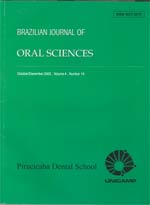
|
Brazilian Journal of Oral Sciences
Piracicaba Dental School - UNICAMP
EISSN:
Vol. 4, No. 13, 2005, pp. 695-706
|
 Bioline Code: os05011
Bioline Code: os05011
Full paper language: English
Document type: Research Article
Document available free of charge
|
|
|
Brazilian Journal of Oral Sciences, Vol. 4, No. 13, 2005, pp. 695-706
| en |
Hypodontia: genetics and future perspectives
Trevor J Pemberton; Parimal Das & Pragna I Patel
Abstract
Tooth development is a complex process of reciprocal interactions that we have only recently begun to understand. With the large number of genes involved in the odontogenic process, the opportunity for mutations to disrupt this process is high. Tooth agenesis (hypodontia) is the most common craniofacial malformation with patients missing anywhere from one tooth to their entire dentition. Hypodontia can occur in association with other developmental anomalies (syndromic) or as an isolated condition (non-syndromic). Recent advances in genetic techniques have allowed us to begin understanding the genetic processes that underlie the odontogenic process and to identify the mechanisms responsible for tooth agenesis. Thus far two genes have been identified by mutational analysis as the major causes of non-syndromic hypodontia; PAX9 and MSX1. Haploinsufficiency of either has been observed to cause the more severe forms of hypodontia whilst point mutations cause hypodontia to varying degrees of severity. With the prevalence of hypodontia having been observed to have increased during the 20th century, the future identification and analysis of its genetic basis is essential to allow us to better treat the condition. The clinician can facilitate this process by collaborating with the human geneticist and referring patients/families with familial hypodontia for investigative research.
Keywords
hypodontia, tooth agenesis, PAX9, MSX1, prevalence, mutations
|
| |
© Copyright 2005 - Piracicaba Dental School - UNICAMP São Paulo - Brazil
Alternative site location: http://www.fop.unicamp.br/brjorals
|
|
